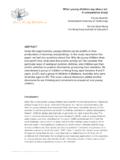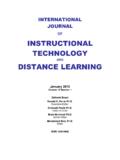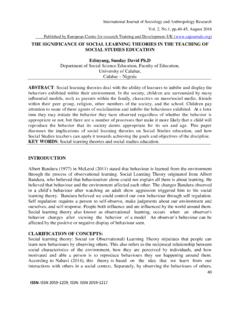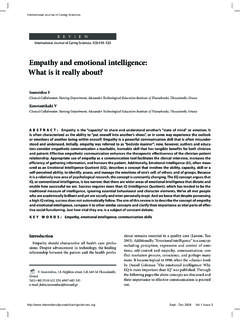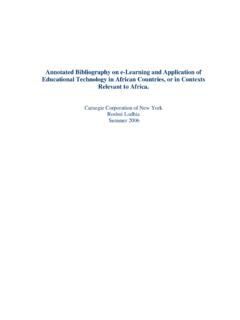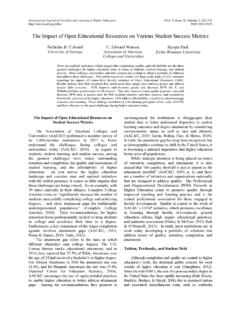Transcription of Understanding the role of critical and creative thinking ...
1 Understanding the role of critical and creative thinking in Australian primary school visual arts education Frances Alter University of New England, Australia Abstract Much attention has been devoted to critical and creative thinking within the field of education in recent years. One reason for this burgeoning interest results largely from research that has shown it is possible to increase students' critical and creative thinking capacities through instruction and practice. In the past this was often regarded as an innate individual disposition and education was thought to have little impact on development (Presseisen, 1999).
2 Another reason for the increased attention given to these forms of thinking is due to rapid sociological changes. With movement to what is often referred to as the information age' the ability to be both a critical and creative thinker is considered an important element of life success. A number of scholars have reasoned that the complex nature of the visual arts provides an excellent platform to actively engage students in critical and creative thinking (Perkins, 1994; Efland 2002; Eisner, 2002;). However, the discipline alone cannot be charged with achieving this.
3 Teachers also must create opportunities for developing thinking . Art teachers cannot assume that teaching facts and technical skills is adequate to the task, since students need to be guided to develop their abilities to reason, inquire and form concepts. This paper discusses theoretical underpinnings and some findings from my case study research concerning the critical and creative thinking orientation of students in primary school art classes. What was highlighted through the study was that, whilst primary teachers had valuable subject expertise and many years of teaching experience behind them, the educative role of the arts in teaching higher order cognitive processes was often missing from their art lessons.
4 During my first three years of employment as a visual arts lecturer, I frequently had the opportunity to oversee university pre-service primary school teacher trainees undertaking their practicum. Observations of numerous primary school classrooms during this time revealed a consistent attitude amongst many teachers that gave art a second-class status. School art' was largely perceived as a fun subject that could be 1 - international Art in Early Childhood Research journal , Volume 1, Number 1. 2009.
5 Sporadically sandwiched between other subjects. Art classes were justified because they had entertainment value. Since students enjoyed these classes, the assumption was that they could not contain any serious thinking or learning. As if to confirm this prejudice, teachers frequently engaged in activities that did little to stretch the cognitive orientation of the subject. Students seemed to be doing mechanical' or tidy' tasks that did not challenge them to think creatively, or reflect upon their ideas and opinions.
6 Many of the supervising teachers were encouraging student trainees to do busywork' in which no one but the teacher did any real planning or decision-making. Needless to say, this was somewhat disheartening. I had invested time and effort in promoting a different conception of arts teaching, a conception that acknowledged that the visual arts offered teachers a powerful teaching tool. Goldberg aptly states: What the artist does through artistic activity is what emancipatory educators encourage: critical , reflective, and creative thinking in the context of society, coupled with expression.
7 The expression might be an attempt to change society or to simply explore its complexities (Goldberg 2001, p. 33). After observing that the cognitive aspects of visual arts education were frequently devalued in the primary classroom, I embarked on a research project that attempted to document the contextual elements of visual arts classrooms in order to identify factors that encouraged higher order thinking skills. Primary school art classrooms in New South Wales Curriculum reforms in Australia in the last two decades appear to have created more opportunities for teachers to use the visual arts as a vehicle for cognitive development.
8 In 1994, educational change in Australia was most evident through the restructuring of the national arts education curriculum framework by the Curriculum Corporation (CC, 1994). Throughout the following decade state syllabuses were progressively introduced in each Australian state. All of these essentially followed a Discipline Based Art education (DBAE) Model, proposed by the national curriculum writers (Emery, 1998). In New South Wales, the current creative arts K-6 syllabus was introduced into primary schools in 2000.
9 Within the new curriculum framework it became mandatory to teach the creative arts (visual arts, drama, music and creative dance) that combine to form one of six key learning areas in the primary curriculum. Art appreciation and art making were the two discipline strands that formed the foundation of learning in the visual arts. Art criticism/aesthetics, art making and art history were the three discipline strands at secondary level. A key learning objective within the primary visual arts syllabus is forming a close relationship between art practice and art appreciation such that one informs the other.
10 To facilitate art making, current syllabus documents recommend teachers provide a 2 - international Art in Early Childhood Research journal , Volume 1, Number 1. 2009. wide range of experiences in creating two- and three-dimensional contemporary and traditional art forms. To guide pupils' conceptual Understanding of art, the syllabus recommends teachers initiate dialogue about works of art in both past and present social contexts. Art appreciation involves pupils in speaking, reading and writing activities.
